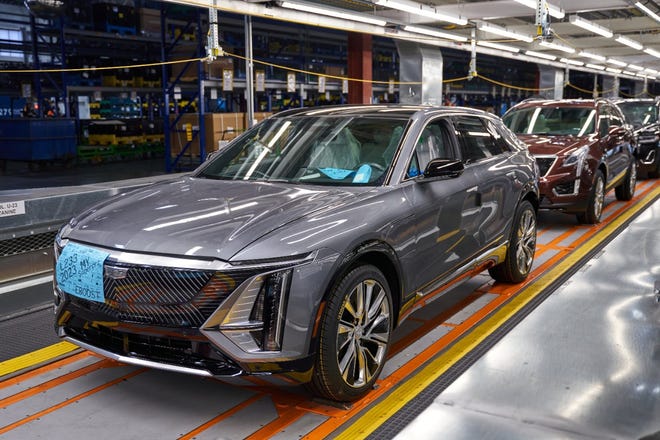General Motors has all the raw materials it needs to get it to the goal of building 1 million electric vehicles in North America by the end of 2025.
On Tuesday the automaker said it has three new supplier agreements that give GM access to lithium, nickel, cobalt and Cathode Active Material (CAM) used in EV batteries.
The new binding supply agreements are:
- LG Chem will supply GM with 968,000 tons of cathode material between now and 2030, enough to build 5 million EVs.
- Livent will provide significant quantities of lithium for high-performance EVs.
- POSCO Chemical will provide a near-term supply of CAM from its South Korean operations from 2023 to 2025. CAM is a key battery material consisting of processed nickel, lithium and other materials that makes up about 40% of the cost of a battery cell.
In December, GM announced a joint-venture deal with POSCO Chemical and in March 2022 GM said the new joint-venture will build a factory in Quebec. That plant is under construction, so until it is ready POSCO will deliver CAM to GM from South Korea.

GM also has a joint venture with LG Energy Solution called Ultium Cells LLC to make battery cells for GM’s future EVs. Ultium Cells is building factories in Ohio, Tennessee and Michigan. The plant in Lordstown, Ohio, starts production in three weeks.
“As we move forward, we will increasingly localize our supply chain, just as we have localized battery cell production,” said GM spokesman David Barnas.
Livent’s performance lithium
GM is investing $35 billion in EVs and self-driving cars through 2025. It’s a big bet on electrification, meaning GM can’t afford a mistake in a launch. GM will launch 30 new EVs by then.
To make sure all that can happen, GM CFO Paul Jacobson said last month the automaker will continue to form partnerships or invest in raw material suppliers to ensure GM has the parts it needs.
“Everything is on the table when it comes to the way we have to be thinking about some of these commodities that might be in tighter supply in the future,” Jacobson said on June 15.
Chemical manufacturer Livent inked a multiyear sourcing agreement to supply GM with battery-grade lithium hydroxide made primarily from lithium extracted at Livent’s brine-based operations in South America.
Lithium hydroxide is crucial to GM’s plans to make higher performance, higher mileage EVs. GM said it will use lithium hydroxide in the Ultium propulsion system that will power the Chevrolet Blazer EV, Chevrolet Silverado EV, GMC Hummer and Cadillac Lyriq.

Livent will supply to GM over a six-year period beginning in 2025 and over the course of the agreement, Livent will increasingly supply battery-grade lithium hydroxide to GM from its manufacturing facilities in the U.S., with the goal of transitioning all of its lithium hydroxide processing for GM to North America.
GM said the agreement helps Livent expand its North American capabilities and secures product for GM’s production.
Localizing production
LG Chem will supply 950,000 tons of CAM to GM beginning the second half of this year through 2030, enough to make five million EVs, GM said.
The CAM secured by GM will be used by Ultium Cells at its three battery cell plants. GM said in a statement that it and LG Chem will also look into building a new factory for CAM production in North America by the end of 2025.
“This agreement demonstrates GM’s commitment to strong supplier relationships, and complements our many other recent EV supply chain announcements,” said Jeff Morrison, GM vice president of Global Purchasing and Supply Chain. “Importantly, GM now has contractual commitments secured with strategic partners for all battery raw material to support our goal of 1 million units of EV capacity by the end of 2025.”
More:GM joint venture gets $2.5 billion government loan to help build EV battery cell plants
More:GM offers rebate on Cadillac Lyriq if drivers sign NDA, agree to be tracked
GM’s done deals
In April, GM locked in a multiyear arrangement with Glencore, a company headquartered in Baar, Switzerland, that will supply GM with cobalt from its Murrin Murrin operation in Australia. Cobalt gives the batteries energy, density and longevity.
GM also inked a deal late last year with rare earth mining and manufacturer MP Materials Corp. to produce alloy and magnets for some of GM’s upcoming EVs.
In December, GM also announced it has a nonbinding memorandum of understanding with German-based supplier VAC, which makes advanced magnetic materials. It will start making those magnets for GM in 2024. Magnets are an essential part of EV motors and drive units.
At that time, GM spokesman David Caldwell told the Free Press that forming partnerships for raw material sourcing secures GM’s supply chain for EVs and makes the materials more North American-focused.
Contact Jamie L. LaReau at jlareau@freepress.com. Follow her on Twitter @jlareauan. Read more on General Motors and sign up for our autos newsletter. Become a subscriber.